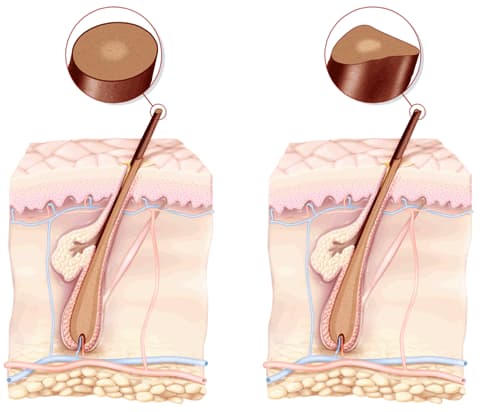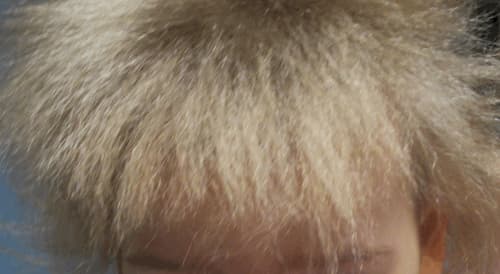Uncombable hair syndrome, as the name suggests, is a condition that makes it rather difficult for a person to comb their hair flat. It’s a very rare hair shaft disorder with only about a hundred reported cases, however, it’s believed that there cases out there that haven’t been reported.
Fortunately, this condition can resolve on its own, but the children who have it can be at the receiving end of teasing and name-calling, which can be quite distressing. While there’s no cure or treatment for it (maybe, save for one), there are some things that parents may be advised to not worsen the condition.
What Is Uncombable Hair Syndrome?
Also known as spun glass hair, cheveux incoiffables, or pili trianguli et canaliculi, uncombable hair syndrome is a type of disorder of the hair shaft like pili torti, monilethrix, or trichorrhexis nodosa.
In uncombable hair syndrome, the shaft of the hair ends up having a flat, triangular or heart-shaped cross section instead of being the normal cylindrical shape, and the angularity is what doesn’t let it be flat, according to MedlinePlus. Additionally, because such hair doesn’t reflect light normally either, it glistens unusually compared to normal hair.

The condition may develop symptoms between the ages of 3 and 12 but as per a 2022 study published in JAMA Dermatology, it is usually seen in infancy and by the time the child reaches adulthood, the physical signs become barely noticeable. Therefore, it improves with age.
What Are The Signs Of Uncombable Hair Syndrome?
The following signs and symptoms of uncombable hair syndrome have been noted:
- Dr, frizzy, and coarse hair
- Hair stands out (instead of lying down flat) from the scalp
- Hair grows slightly slower
- Hair is usually light-coloured
- Hair looks shiny
- Bald patches (though rare)

While uncombable hair syndrome can be an isolated occurrence, it can also be associated with a health condition, in which case, it can be accompanied by other symptoms as well.
What Causes Uncombable Hair Syndrome?
According to the National Institute of Health (NIH), uncombable hair syndrome is the result of genetic mutations in three genes – PADI3, TGM3, and TCHH – which are involved in the formation of the hair shaft. The faulty gene might be passed down from both the parents (autosomal recessive) or just one (autosomal dominant) for the child to develop this condition.
Some of the health conditions that uncombable hair syndrome has been associated with include:
- Ectodermal dysplasia
- Retinal dysplasia
- Oligodontia
- Juvenile cataract
Additionally, according to a 2022 study published in Acta Dermatovenerol APA, this condition can also co-occur with:
Does Uncombable Hair Syndrome Go Away?
Uncombable hair syndrome tends to go away on its own. As per a 2019 research in Skin Appendages Disorder, it will resolve gradually at the time of puberty. So, you’re unlikely to notice an overnight change.
How To Treat Uncombable Hair Syndrome?
Being a genetic condition, there’s no cure or treatment for uncombable hair syndrome. But since the condition goes away on its own, your doctor might advise you to stay patient and not aggravate the problem by being gentle with the hair. This may include things like avoiding chemical treatments, overbrushing, and minimising the use of heat-styling tools.

One treatment option that has been researched specifically for uncombable hair syndrome is the use of biotin. In a 1985 study published in the Journal of the American Academy of Dermatology, the intake of 0.3 mg of oral biotin 3 times a day showed improvement in hair growth, “strength and combability of the hair” of 1 patient. There were 2 other patients, however, they also had ectodermal dysplasia with this condition, and their hair improved without biotin over a period of 5 years.
This is a very small research, and while biotin may have promising potential, you must consult a medical professional for an accurate diagnosis of the problem along with the best course of action.
Conclusion
Uncombable hair syndrome can be a problematic hair concern, especially as it affects children during a crucial time of their social development. While it has no treatment, your doctor might advise you to handle the hair very gently so you don’t make it worse. It should eventually go away on its own.
If you’re experiencing this problem as well, make sure to consult a board-certified medical professional for a thorough consultation for diagnosis and potential treatment options.
Reviewed and approved by Trichologist Yaprak Yazan
FAQ
How rare is uncombable hair?
A 2022 study in JAMA Dermatology reported that there are only 100 known cases of uncombable hair syndrome, so it is a very rare condition. But it’s, of course, possible that not all cases of this condition have been reported.
Can uncombable hair be straightened?
You might not be able to straighten your hair if you have uncombable hair syndrome, and you also have to keep in mind that treatments and tools for hair straightening might cause more damage to your hair.
Can you braid uncombable hair syndrome?
You may be able to style your hair with braids if you have uncombable hair syndrome. However, again, it’s best to talk to a professional. Tight braids can also cause a type of hair loss known as traction alopecia.
Did Einstein have uncombable hair syndrome?
While it’s been speculated that Albert Einstein might’ve had uncombable hair syndrome because of his untamed hair being widely photographed, in truth, there’s no proof. Even as he was young, there are photos of Einstein with fairly kempt and smoothed-out hair, so it seems unlikely that it was a hair shaft disorder.
Does Boris Johnson have uncombable hair syndrome?
Like Einstein, Boris Johnson is also believed to have uncombable hair syndrome because of how many times they’ve been seen standing up on his head. But photographers of him as a youngster show a fairly tame and silky mane, so it’s unlikely that he has this condition.


